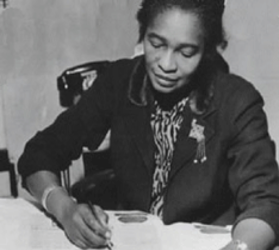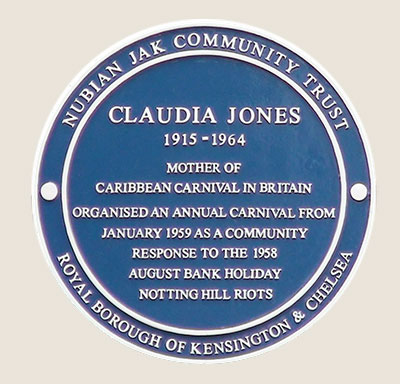
Claudia Jones (1915-1964)
Claudia Jones (née Cumberbatch) was born in Trinidad in 1915, and her family emigrated to New York when she was eight years old. Growing up, she faced emotional and financial challenges, including losing her mother when she was 13 and falling ill with tuberculosis at 17, which led to lengthy hospital stays. She was also exiled and deported to the United Kingdom from America in 1955 for being a communist and civil rights activist.
Jones began writing for a Harlem journal reporting on local events as a young woman. After hearing the Communist Party’s defence of the Scottsboro Boys in 1936, she worked on the Young Communist League’s newspaper, later becoming state education director and chairperson for the YCL. In 1937 she joined the editorial staff of the Daily Worker, rising by 1938 to become editor of the Weekly Review. After the Young Communist League became American Youth for Democracy during World War II, Jones became editor of its monthly journal, Spotlight.
After the war, Jones became executive secretary of the Women’s National Commission, secretary for the Women’s Commission of the Communist Party USA (CPUSA), and in 1952 took the same position at the National Peace Council. In 1953, she took over the editorship of Negro Affairs. Jones began to campaign for job training programs, equal pay for equal work, government controls on food prices, and funding for wartime childcare programs.
After being deported for her work in 1955 to the United Kingdom, she immediately joined the Communist Party of Great Britain (CPGB) and remained a member for the rest of her life. She formed a relationship with the Indian activist Abhimanyu (Manu) Manchanda (1919-1985), who was also an activist. In 1958, she founded Britain’s first major black newspaper, the West Indian Gazette (WIG).
Following the 1958 riots in Notting Hill, Claudia organized a walk from Powis Square to Tavistock Square to show off some of the more positive aspects of Caribbean culture. Although containing dancers and steel drum players, the walk was not an official carnival but a cultural statement. She also held indoor Carnivals at a hall in St Pancras, which gained in popularity. Along with Rhaune Laslett, she was responsible for inspiring the carnival culture in Britain.
After a continual struggle with her poor health Claudia Jones died at the age of 47 in 1964. She is buried in Highgate Cemetery next to Karl Marx.
In 2008, NJCT unveiled a commemorative plaque to pay tribute to her as one of Britain’s most significant post-war Caribbean personalities.
The plaque was unveiled by His Excellency John S. Jeremy, High Commissioner for Trinidad & Tobago and the Honourable Joanna Garner, Mayor of the Royal Borough of Kensington & Chelsea. The Notting Hill Carnival is very much part of the identity of the Royal Borough and it is fitting that one of the most important people involved in its inception is recognised in this way. Councillor Merrick Cockell Leader of the Royal Borough of Kensington and Chelsea.
We are proud to commemorate Claudia Jones, who established the very first carnival on the streets of Notting Hill and recognised the power of the arts to bring people from different communities together. Cllr Colin Barrow, Leader of Westminster City Council
We are pleased to be associated with this commemorative event to celebrate the life of Claudia Jones. A true daughter of the soil, Ms. Jones’ efforts to promote our culture and bring recognition to the early Caribbean diaspora and thereby create history in the United Kingdom must be heralded. The High Commission for the Republic of Trinidad and Tobago
The UK Centre for Carnival Arts is proud to partner with the Nubian Jak Trust in celebrating the life of one of the most influential women from the UK Carnival scene. Claudia Jones is an inspiration to everyone who has ever wanted to make a difference. Paul Anderson, Executive Director of UKCCA
As the current guardians of her legacy, the London Notting Hill Carnival board is delighted that Claudia Jones is being recognised in this way. We hope that these plaques will remind us of all of the sacrifices that others have made, so that today we can enjoy the freedoms of a truly multicultural Britain. Allyson Williams, Interim Chair of LNHCL
Claudia was formidable, a woman with a profound vision to use culture as the scale to balance the differences between peoples. Carnival Village intends to build on this vision that will establish a home for the Carnival and is proud to honour this great pioneer. Shabaka Thompson from the Carnival Village.
It is wonderful that someone who gave so much to her community, and who stood up for justice and equality, should finally be recognized for giving Britain its greatest symbol of cultural diversity – The Notting Hill Carnival. Jak Beula
Locations: Blue Corner of Tavistock Rd and Portobello Road (Carnival Sq) Ladbroke Grove, London, W11
Bronze: Carnival Village, The Tabernacle, Powis Square, London W11.

